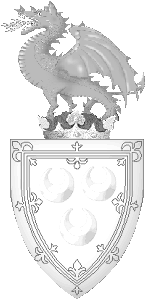|
Sir Walter Scott's, "The
Abbott", and the description of the Seton's Cannongate House:
Entered by, under
..."one of the arched passages which afforded an outlet to the Canongate
from the houses beneath, a passage, graced by a projecting shield
of arms, supported by two huge foxes of stone". Therein was, "A
paved court, decorated with large formal vases of stone, in which
yews, cypresses, and other evergreens, vegetated in sombre sullenness, and gave a
correspondent degree of solemnity to the high and heavy building
in front of which they were placed as ornaments, aspiring towards
a square portion of the blue hemisphere, corresponding exactly in
extent to the quadrangle in which they were stationed, and all
around which rose huge black walls, exhibiting windows in rows of
five stories, with heavy architraves over each, bearing armorial
and religious devices".
Upon entering the
Lord Seton's Lodging, one "pulled the bobbin, and the latch,
though heavy and massive... (and) entered the large hall, or
vestibule, dimly enlightened by latticed casements of painted
glass, and rendered yet dimmer through the exclusion of the
sunbeams, owing to the height of the walls of those buildings by
which the court-yard was enclosed. The walls of the hall
were surrounded with suits of ancient and rusted armour, interchanged with huge
and massive stone escutcheons, bearing double tressures, fleured
and counter-fleured, wheat-sheaves, coronets, and so forth..."
|

